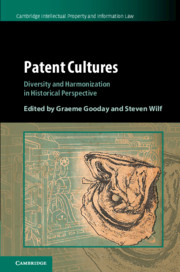56 results
Part V - Asia
-
- Book:
- Patent Cultures
- Published online:
- 23 March 2020
- Print publication:
- 26 March 2020, pp 271-340
-
- Chapter
- Export citation
Contributors
-
- Book:
- Patent Cultures
- Published online:
- 23 March 2020
- Print publication:
- 26 March 2020, pp x-xii
-
- Chapter
- Export citation
16 - Postscript
- from Part VI - Epilogue
-
-
- Book:
- Patent Cultures
- Published online:
- 23 March 2020
- Print publication:
- 26 March 2020, pp 343-346
-
- Chapter
- Export citation
Contents
-
- Book:
- Patent Cultures
- Published online:
- 23 March 2020
- Print publication:
- 26 March 2020, pp v-vii
-
- Chapter
- Export citation
Part II - Americas
-
- Book:
- Patent Cultures
- Published online:
- 23 March 2020
- Print publication:
- 26 March 2020, pp 89-144
-
- Chapter
- Export citation
Part IV - Central and Eastern Europe
-
- Book:
- Patent Cultures
- Published online:
- 23 March 2020
- Print publication:
- 26 March 2020, pp 199-270
-
- Chapter
- Export citation
Copyright page
-
- Book:
- Patent Cultures
- Published online:
- 23 March 2020
- Print publication:
- 26 March 2020, pp iv-iv
-
- Chapter
- Export citation
Tables
-
- Book:
- Patent Cultures
- Published online:
- 23 March 2020
- Print publication:
- 26 March 2020, pp ix-ix
-
- Chapter
- Export citation
Note on the Cover Image
-
- Book:
- Patent Cultures
- Published online:
- 23 March 2020
- Print publication:
- 26 March 2020, pp xvi-xvi
-
- Chapter
- Export citation
Preface
-
- Book:
- Patent Cultures
- Published online:
- 23 March 2020
- Print publication:
- 26 March 2020, pp xiii-xiii
-
- Chapter
- Export citation
Acknowledgments
-
- Book:
- Patent Cultures
- Published online:
- 23 March 2020
- Print publication:
- 26 March 2020, pp xiv-xv
-
- Chapter
- Export citation
Figures
-
- Book:
- Patent Cultures
- Published online:
- 23 March 2020
- Print publication:
- 26 March 2020, pp viii-viii
-
- Chapter
- Export citation
Part III - Southern Europe
-
- Book:
- Patent Cultures
- Published online:
- 23 March 2020
- Print publication:
- 26 March 2020, pp 145-198
-
- Chapter
- Export citation
Part VI - Epilogue
-
- Book:
- Patent Cultures
- Published online:
- 23 March 2020
- Print publication:
- 26 March 2020, pp 341-346
-
- Chapter
- Export citation
1 - Diversity versus Harmonization in Patent History
- from Part I - Introductory
-
-
- Book:
- Patent Cultures
- Published online:
- 23 March 2020
- Print publication:
- 26 March 2020, pp 3-37
-
- Chapter
- Export citation
Index
-
- Book:
- Patent Cultures
- Published online:
- 23 March 2020
- Print publication:
- 26 March 2020, pp 347-362
-
- Chapter
- Export citation
Part I - Introductory
-
- Book:
- Patent Cultures
- Published online:
- 23 March 2020
- Print publication:
- 26 March 2020, pp 1-88
-
- Chapter
- Export citation

Patent Cultures
- Diversity and Harmonization in Historical Perspective
-
- Published online:
- 23 March 2020
- Print publication:
- 26 March 2020
Andreas Marklund and Mogens Rüdiger (eds.), Historicizing Infrastructure. Aalborg: Aalborg University Press, 2017. Pp. 235. ISBN 978-87-7112-594-8. DKr 298.00 (hardcover).
-
- Journal:
- The British Journal for the History of Science / Volume 51 / Issue 2 / June 2018
- Published online by Cambridge University Press:
- 31 May 2018, pp. 324-326
- Print publication:
- June 2018
-
- Article
- Export citation
CONTENTS
-
- Book:
- Domesticating Electricity
- Published by:
- Pickering & Chatto
- Published online:
- 05 December 2014, pp v-v
-
- Chapter
- Export citation



